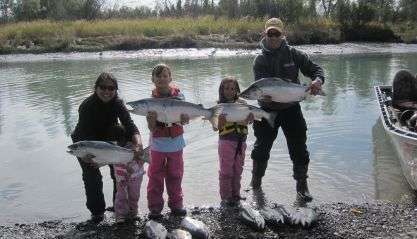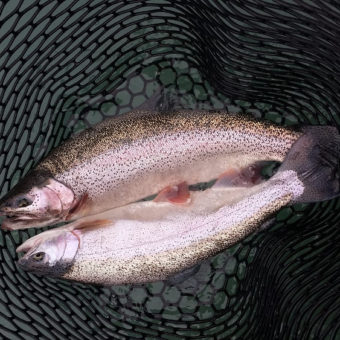Kenai Peninsula Clamming
Razor Clams from Cook Inlet.
Alaska Clam Digging. Razor clams are plentiful on the beaches of the eastern shores of Cook Inlet. Clam Gulch and Deep Creek are the most popular beaches for digging. Those who have 4 wheel drive vehicles can drive down the beach and dig clams in less crowded areas. However, the clams are very plentiful and easy to find once you learn what to look for.
Clams are most easily taken during negative low tides. Check our tide table to find the best days for clamming. To find razor clams, simply walk along the wet sand and look for a dimple. The dimple is created by the clams siphon. Dig next to the dimple and carefully reach in with your hand until you feel the shell of the clam. Pinch the top of the shell until the foot of the clam releases from the bedrock below. Then, pull the clam out and add him to your bucket. Often, you will find several clams in one hole.
A word of caution is in order. Razor clams got their name for a reason. The shells are very brittle and break easily. The shells, when broken, are very sharp. So, reach into the sand carefully and when you dig, do so a few inches away from the dimple and not on top of it.
Mark Glassmaker can provide guests with buckets, boots and shovels for clam digging. Be sure to obtain a tide book and shellfish harvest permit (free). Give clamming a try during your visit.
Driving Directions: From the intersection of Sterling Highway and Redoubt Avenue, proceed west on Sterling Highway, over the Kenai River bridge. Continue south on Sterling Highway toward Homer. Clam Gulch is on the wey to Deep Creek which is located at mile point 137. Plan to be on the beach at least 1 hour before low tide.
Steamer clams in Kachemak Bay.
Steamer clams can be found on any number of the rocky beaches across from Homer, in Kachemak Bay. Jakaloff bay is one good location. Getting to the steamer beaches across from Homer requires the services of a water taxi. Your captain can usually recommend an ol’ favorite beach and he’ll drop you off at low tide and return in a few hours. The digging is strenuous but rewarding. You’ll find these nice sized clams 3-4 inches below the surface and generally in groups of two or three. A three prong rake is the tool to use. You are allowed far more than you really need and a five gallon bucket half full is typically enough for even the heartiest of clam lovers. Just boil in your favorite broth and serve.
To check the tide tables for the best Alaska Clam Digging tides, click here. Remember the best clam tides are the ones with minus lows.



















































